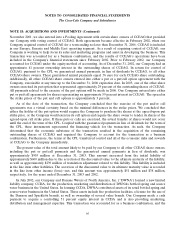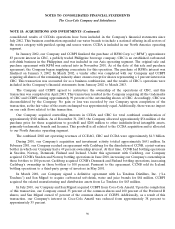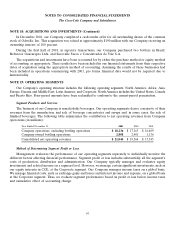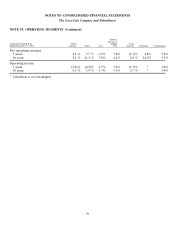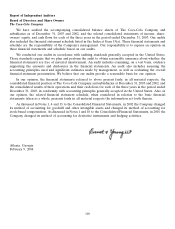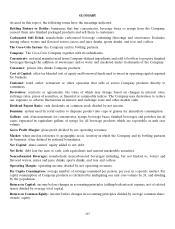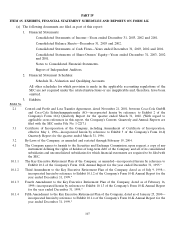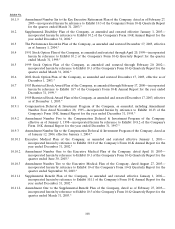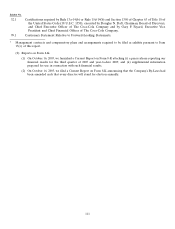Coca Cola 2003 Annual Report Download - page 106
Download and view the complete annual report
Please find page 106 of the 2003 Coca Cola annual report below. You can navigate through the pages in the report by either clicking on the pages listed below, or by using the keyword search tool below to find specific information within the annual report.GLOSSARY
As used in this report, the following terms have the meanings indicated.
Bottling Partner or Bottler: businesses that buy concentrates, beverage bases or syrups from the Company,
convert them into finished packaged products and sell them to customers.
Carbonated Soft Drink: nonalcoholic carbonated beverage containing flavorings and sweeteners. Excludes,
among others, waters and flavored waters, juices and juice drinks, sports drinks, and teas and coffees.
The Coca-Cola System: the Company and its bottling partners.
Company: The Coca-Cola Company together with its subsidiaries.
Concentrate: material manufactured from Company-defined ingredients and sold to bottlers to prepare finished
beverages through the addition of sweeteners and/or water and marketed under trademarks of the Company.
Consumer: person who drinks Company products.
Cost of Capital: after-tax blended cost of equity and borrowed funds used to invest in operating capital required
for business.
Customer: retail outlet, restaurant or other operation that sells or serves Company products directly to
consumers.
Derivatives: contracts or agreements, the value of which may change based on changes in interest rates,
exchange rates, prices of securities, or financial or commodity indices. The Company uses derivatives to reduce
our exposure to adverse fluctuations in interest and exchange rates and other market risks.
Dividend Payout Ratio: cash dividends on common stock divided by net income.
Fountain: system used by retail outlets to dispense product into cups or glasses for immediate consumption.
Gallons: unit of measurement for concentrates, syrups, beverage bases, finished beverages and powders (in all
cases, expressed in equivalent gallons of syrup) for all beverage products which are reportable as unit case
volume.
Gross Profit Margin: gross profit divided by net operating revenues.
Market: when used in reference to geographic areas, territory in which the Company and its bottling partners
do business, often defined by national boundaries.
Net Capital: share-owners’ equity added to net debt.
Net Debt: debt less the sum of cash, cash equivalents and current marketable securities.
Noncarbonated Beverages: nonalcoholic noncarbonated beverages including, but not limited to, waters and
flavored waters, juices and juice drinks, sports drinks, and teas and coffees.
Operating Margin: operating income divided by net operating revenues.
Per Capita Consumption: average number of servings consumed per person, per year in a specific market. Per
capita consumption of Company products is calculated by multiplying our unit case volume by 24, and dividing
by the population.
Return on Capital: income before changes in accounting principles (adding back interest expense, net of related
taxes) divided by average total capital.
Return on Common Equity: income before changes in accounting principles divided by average common share-
owners’ equity.
103




